Road signs in Argentina
Road signs in Argentina are similar to those of other South American countries. They are something of a compromise between the Vienna Convention signs used in Europe and the U.S. system. Argentina has right-hand traffic.
The most recent versions of Argentine road signs were introduced in 1994, with the promulgation of Law 24.449 by the Congress of Argentina, with the purpose of establishing a single rules system within the whole country.[1]
Signs system
- Regulatory signs
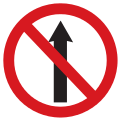 No straight ahead
No straight ahead Do not enter
Do not enter.svg.png) No motor vehicles
No motor vehicles.svg.png) No motorcycles
No motorcycles.svg.png) No bicycles
No bicycles.svg.png) No trucks
No trucks.svg.png) No pedestrians
No pedestrians No U-turn
No U-turn- File::Argentina road sign R6.svgNo overtaking
 No honk horn
No honk horn No parking
No parking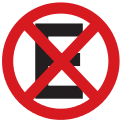 No stopping
No stopping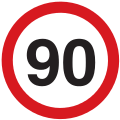 Maximum speed limit (90 km/h)
Maximum speed limit (90 km/h)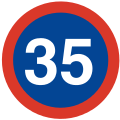 Minimum speed limit (35 km/h)
Minimum speed limit (35 km/h) Parking allowed
Parking allowed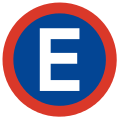 Exclusive parking
Exclusive parking.svg.png) Motorcycles only
Motorcycles only.svg.png) Bicycles only
Bicycles only.svg.png) Turn right
Turn right.svg.png) Turn left
Turn left.svg.png) Straight ahead
Straight ahead.svg.png) Pass on right
Pass on right- File::Argentina road sign R22 (B).svgPass on left
 Stop - Customs Checkpoint
Stop - Customs Checkpoint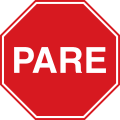 Stop
Stop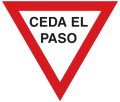 Yield
Yield
- Warning signs
 Railroad crossing (advance warning)
Railroad crossing (advance warning) Railroad crossing
Railroad crossing Railroad level crossing (comprising two or more tracks)
Railroad level crossing (comprising two or more tracks).svg.png) Stop ahead (200 m)
Stop ahead (200 m).svg.png) Yield ahead (200 m)
Yield ahead (200 m)
- Information signs
 National route
National route Provincial route
Provincial route Highway
Highway End of highway
End of highway No-exit street
No-exit street Airport
Airport Beach
Beach Watering place
Watering place Coffee house
Coffee house Camping
Camping Post office
Post office Bus stop
Bus stop Motor home parking
Motor home parking Parking
Parking Fuel station
Fuel station Tire shop
Tire shop Hotel
Hotel Hospital
Hospital Police
Police Tourist attraction
Tourist attraction Rest area
Rest area Restaurant
Restaurant Museum
Museum Park
Park Car repair shop
Car repair shop Telephone
Telephone Taxi stop
Taxi stop Aerial lift
Aerial lift Rail terminal
Rail terminal Bus terminal
Bus terminal Destinations
Destinations City reached
City reached Street name
Street name
- Historic signs
 School warning
School warning School warning
School warning Distance travelled
Distance travelled Railroad crossing
Railroad crossing Railroad crossing
Railroad crossing Orientative
Orientative Taxis stop
Taxis stop
References
- ↑ Law n° 24.449 (separated by Province) on Agencia Nacional de Seguridad Vial de Argentina website (Archive), 30 Mar 2014
External links
| Wikimedia Commons has media related to Diagrams of road signs of Argentina. |
- Agencia Nacional de Seguridad Vial - Normativa
- Ley n° 24.449 (with diagrams)
- Dirección Nacional de Vialidad
This article is issued from Wikipedia - version of the 9/24/2016. The text is available under the Creative Commons Attribution/Share Alike but additional terms may apply for the media files.